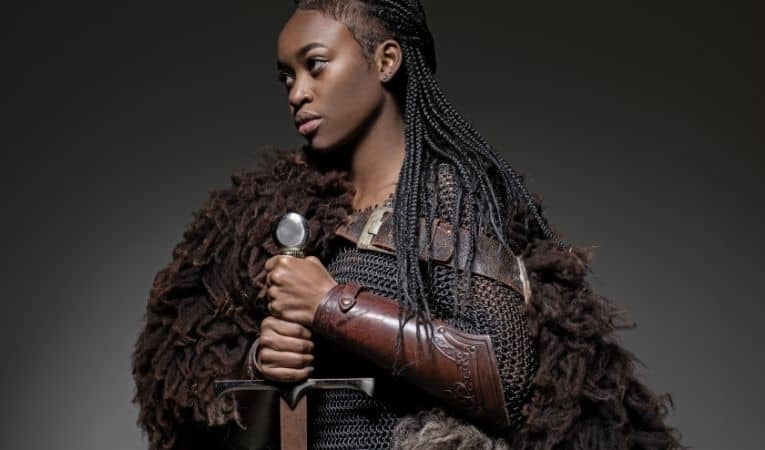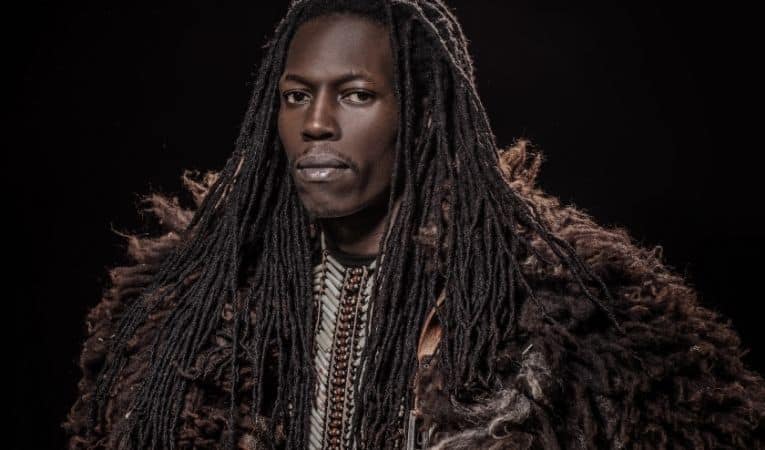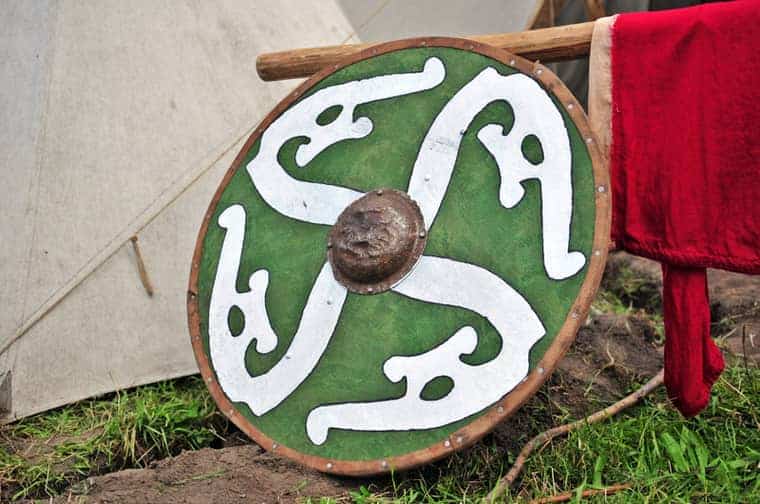The stereotypical image of a Viking is that they had white or light-colored skin and blonde, or sometimes brown, hair.
But did all of the Vikings look like that? Were there any black Vikings who had brown skin?
According to reliable historical evidence, a small number of Vikings had black—or brown skin.
For centuries, dark-skinned people willingly traveled to Scandinavia or were forcibly taken there as slaves.
Over time, some assimilated with the Vikings through farming, marriage, combat, and other cultural factors.
Learning about the different races of people found in Viking culture—even if they were few in number—is important to learn when studying the history of the ancient Scandinavian people.
Also, see What Did the Vikings Look Like? to learn what scientists believe about their appearances.

What Is the Historical Evidence There Were Black Vikings?
Depictions of Vikings in twenty-first-century popular culture are more about entertainment than historical accuracy.
Some modern stories accurately portray images of the Viking Age.
Yet, contrary to the historical evidence, others imagine the ancient Scandinavians as superheroes or action movie stars, like Thor from the Marvel Cinematic Universe.
Viking racial diversity
While most were white, not all were. Just like it’s a stereotype that Vikings had horns on their helmets, it’s similarly inaccurate to say that they all had peach-colored skin.
Ancient Scandinavia was permeated with myth, but that black people weren’t among the Vikings isn’t one of them.
Viking history shows that a few black people were a part of its culture. [1]
Black Vikings didn’t have Scandinavian ancestry. At least the first generation didn’t.
But over time, through cultural assimilation, it’s accurate to say that a few among the Vikings had brown skin.
Also, see Did Vikings Wear Dreadlocks? to learn more.

What Is the Evidence for Black Vikings?
For people interested in the real story of the Vikings, as opposed to the versions found in popular culture, historical accuracy is important.
One of the best books that help people separate fact from fiction in Viking history on this issue is A History of the Vikings by historian Gwyn Jones.
Jones offers evidence of racial diversity among Scandinavian people in the book, though not a lot, including during the Viking Age.
He writes, “The viking peoples who lived between the neck of Jutland and the Lofotens, Sogn, and Uppsala, were not all alike, and emphatically not of one ‘pure’ nordic race.
He continues, “But two main types of Scandinavian have always been recognizable: the one tall of stature, fair or ruddy complexioned, light-haired, blue-eyed, long of face and skull; the other shorter, dark-complexioned, brown- or dark-haired, brown-eyed, broad-face and round of skull.” [2]
Jones argues that the myth of an utterly white race of people—perpetuated by 20th-century propaganda—and perhaps partly encouraged by depictions of Vikings in modern popular culture is factually false.
Though white people were certainly the majority in Scandinavia during the Viking Age, there were minority races who had brown skin tones.
Also, see Why Do Soldiers Say Say Until Valhalla? to learn more.

White and Black Skin Color in Viking-Age Literature
In ancient Scandinavian literature, poetic references to people’s skin color are not unusual.
Descriptions of white people appear in literature, like poems, in the Viking Age.
For example, in a work of Icelandic origin, the features of a white mother and son are praised:
“Her brows were bright, her breast was shining, whiter her neck than new-fallen snow. Blonde was his hair, and bright his cheeks, grim as a snake’s were his glowing eyes.”
It continues, “While white skin tones were celebrated in certain writings, Jones argues that racial tensions were not necessarily severe, writing, “there is no evidence of prejudice or dissension between the two [Scandinavian] types” [3].
Elsewhere, Jones gives examples of people with brown skin in ancient Scandinavian literature.
He writes, “Harald Fairhair was the first king of all Norway; his father was Halfdan the Black (svarti), and two of his sons were likewise called Halfdan, one nicknamed the White (hviti), the other, reminiscently, the Black.” [4]
Some historians, like Jones, note that the moniker “the Black” may reference hair color.
While this may be partially true, the implications likely refer to a person with a dark complexion as well.
If the description exclusively referred to hair color alone, it may raise questions about the son nicknamed “the White” (Jones, p. 137).
Jones gives another example from a Scandinavian work called Egils Saga: “Thorolf was tall and handsome like his mother’s people, but Grim took after his father and was black and ugly.”
The passage continues, “Grim’s sons, Thorolf and Egill, born out in Iceland, repeated the pattern: Thorolf was the image of his uncle, tall, handsome, and sunny-natured; Egill was black, even uglier than his father, tortuous and incalculable.” [5].
While such descriptions may offend modern readers, Jones notes that these nicknames “were purely descriptive, like the Short, the Tall, the Fat, the Slender, the Bald or the Hairy-beeked” and contain no negative intent in their day [6].
Women play an important role in Viking society. See 15 Facts About Viking Women to learn more.

How Did Black People Get to Scandinavia?
People with dark skin aren’t native to Scandinavia but arrived in the region in other ways.
As previously mentioned, the most common reason first-generation black people fled to northern Europe was as willing travelers. Yet, others were taken there as slaves.
The second generation and beyond were born in the region, though their ancestry was elsewhere.
Some black people willingly traveled to Scandinavia
Some black people were in Scandinavia during the Viking Age because they traveled there.
Dark-skinned people from Northern Africa and certain places in southern Europe, like Spain, explored unknown areas just like other Europeans and Asians who sought to discover what foreign lands were like.
Like others, black travelers sought resources like fertile land, meaty game, and valuable goods.
Over time, some settled in the regions they explored and settled in Northern Europe.
Also, see What Hairstyles Did the Vikings Have?
Some black people were escaping hardship
Another reason black people were in Scandinavia during the Viking Age was that they fled there.
Black people were used as slaves in other parts of Europe, and when they succeeded at escaping, they fled, and sometimes they fled north to Scandinavia.
Former slaves had the difficult task of resettling in foreign lands. Nevertheless, some successfully assimilated into Viking culture.
For these reasons, many historians believe it’s accurate to refer to “black Vikings.”
Also, see Did Vikings Paint Their Faces? to separate fact from fiction.
Some black people were taken to Scandinavia as slaves
Slavery is another reason black people were in Scandinavia during the Viking Age. The Vikings took slaves from other places in Europe and forced them to work for them instead.
While there are many accounts of the Vikings taking and using white European slaves, there may have also been black people among them.
Jones writes: “The total numbers are unknown, but human booty was easy to collect, transport and dispose of in the slave markets all across Europe from Dublin to Bolgar. An internal Scandinavian market was also established, on the islands at the mouth of the Gota, where the three nascent kingdoms met.”
He continues, “Craftsmen we may suppose were often brought home by their captors, as were certainly many younger women, by whom slave numbers were to some extent replenished…The labor force of a substantial freeman’s farm seem normally to have included some half-dozen slaves…” [7].
Archaeological findings show more black people in Denmark than in countries north like Norway and Sweden.
This is probably the case because Denmark is closer to the other countries of Europe where black people lived at the time.
In addition, it’s known that Viking raids eventually extended as far south as the Mediterranean world and that black people were forcibly taken from that region.
Jones writes that in Spain, “The Vikings spent an unharassed week rounding up prisoners for ransom, though some, probably [black], they kept as souvenirs of the voyage. These poor wretches, fir grom, blue men, blamenn, black men (or merely men with dark skins), for the most part ended up in Ireland” [8].
Slavery eventually faded
Like many aspects of Viking life, slavery in ancient Scandinavia was ruthless and brutal. After the arrival of Christianity, the institution of slavery weakened, but it was not abolished altogether.
The Northern European economy was dependent on slave labor. Over time, however, slavery faded, first in the urban areas and eventually in rural areas.
Intermarriage and Settlements Among the Vikings
The Viking Age was marked by extensive exploration, trade, and settlement. As the Vikings ventured beyond their Scandinavian homelands, they came into contact with various cultures and populations.
This exposure often led to intermarriages, especially in regions where they established settlements. Over time, these settlements became melting pots of cultures.
Intermarriage was not just a byproduct of these settlements but a significant factor in the assimilation process.
Marrying locals often facilitated better relations with neighboring communities, ensuring the Vikings’ survival and prosperity in foreign lands.
Historical records and archaeological findings provide evidence of these mixed-race marriages. For instance, Norse sagas occasionally mention Viking chieftains marrying local women of prominence.
Similarly, archaeological findings reveal that burial sites in regions with Viking settlements sometimes unearthed artifacts from various cultures, hinting at the diverse familial ties formed through intermarriage.
Also, see How Vikings Got Tattoos and Why to learn more.
References
[1] A History of the Vikings. Gwyn Jones.
[2] Ibid. p. 67
[3] Ibid. p. 68.
[4] Ibid. p. 68
[5] Ibid. p. 128.
[6] Ibid. p. 68.
[7] Ibid. p. 21-22.
[8] Ibid. p. 216.
Sources:
[1] A Historical Encyclopedia of World Slavery
[2] The Abolition of Slavery in Scandinavia
[3] The Viking People – Britannica
[4] Slave Trade – Britannica
